What is language? (4)
A system for representing and communicating information about the world using symbols and rules.
Divided into natural languages (used by humans) and formal languages (finite systems with defined signs and rules).
Human language is unique because it is generative (can create infinite expressions).
Capable of representing abstract concepts, unlike many animal communication systems.
What are formal languages, and how do they differ from natural languages? (2)
Formal languages are finite systems of signs and rules designed for specific purposes (e.g., programming languages, mathematics).
Unlike natural languages, they lack the flexibility and generative nature of human communication.
How does human language differ from animal communication? (3)
Human language is open and generative, allowing the creation of infinite combinations of ideas and expressions.
Animal communication is often closed and finite, limited to specific signals (e.g., bee dances, primate calls).
Human language can convey abstract ideas, while animal languages generally focus on immediate needs or situations.
Picture demonstrating language groups 1:
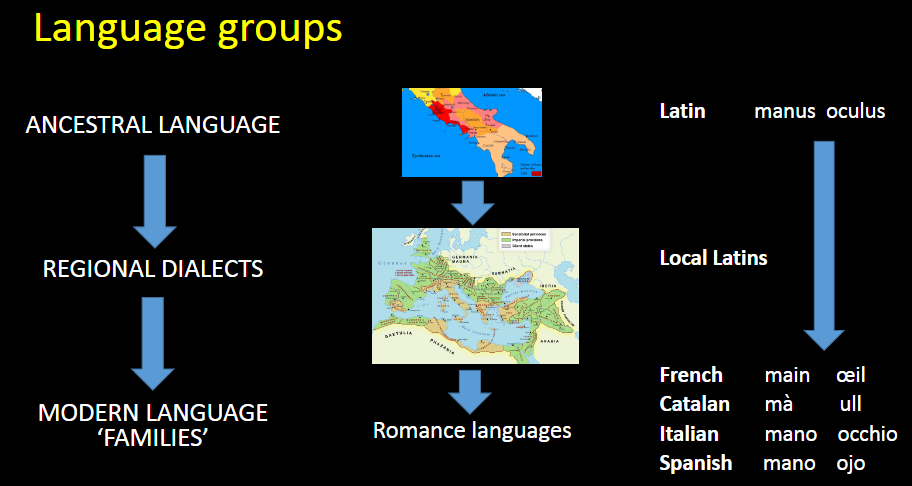
Picture demonstrating language groups 2:
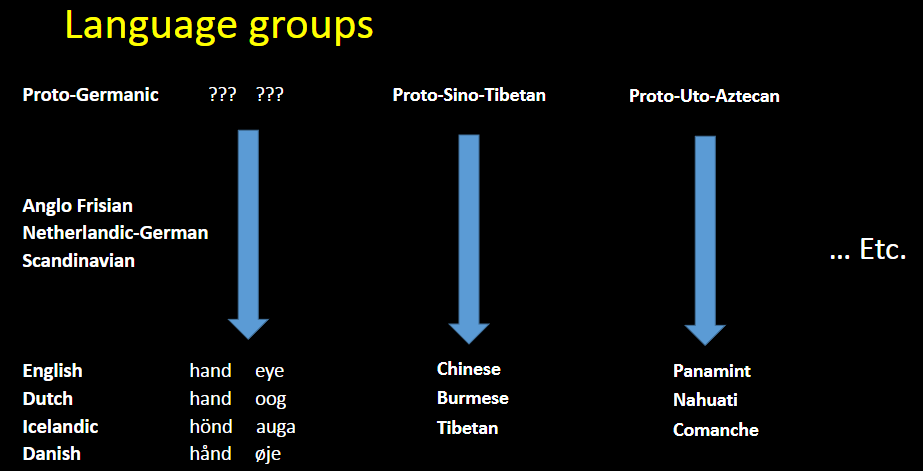
Picture demonstrating Language families – number of languages:
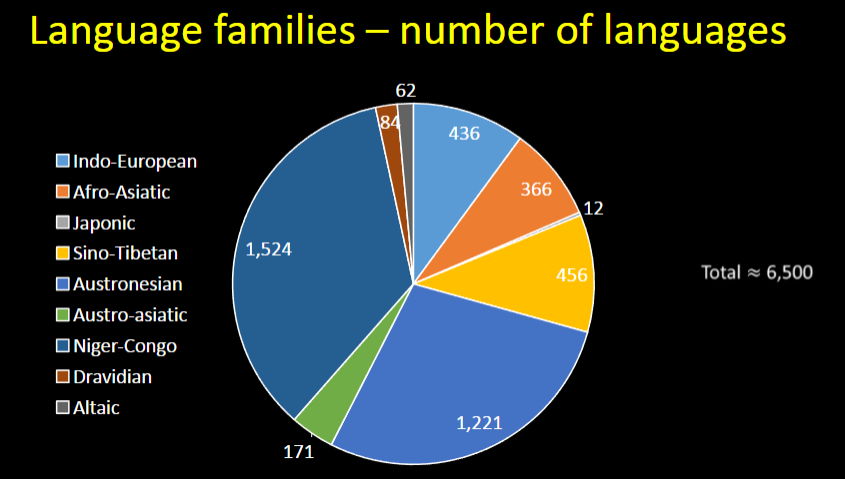
Language families – relative number ofspeakers:
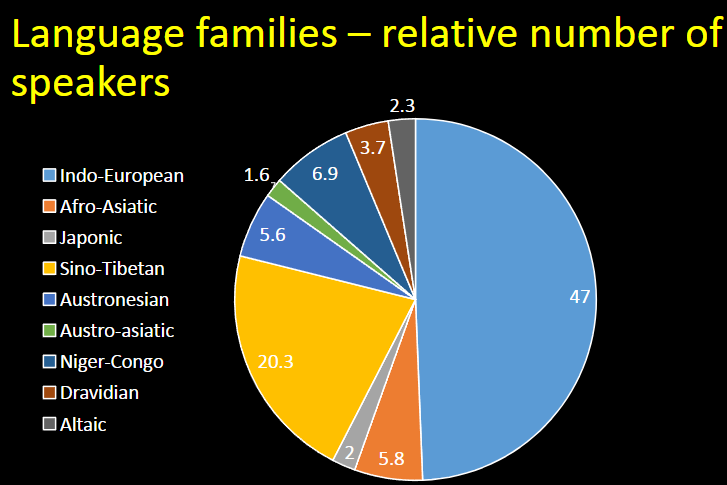
What is articulation in language? (3)
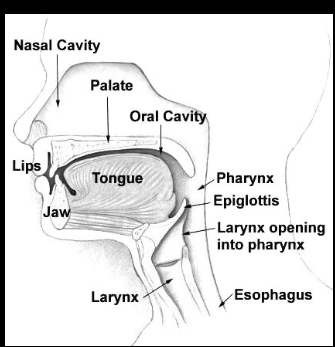
Articulation refers to the movement of the tongue, lips, and jaw to modify a sound wave.
It involves the physical production of speech sounds (phonetics).
Sounds are classified by place and manner of articulation.
What are the classifications of articulation based on the place of articulation? (3)
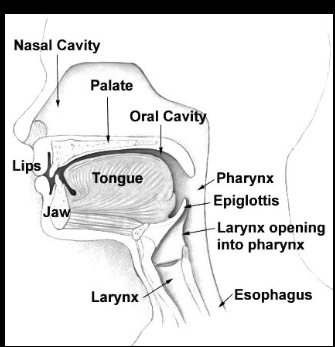
Labial: Sounds produced using the lips (e.g., "p" and "b").
Alveolar: Sounds produced using the tongue and the ridge behind the teeth (e.g., "t" and "d").
Palatal: Sounds produced using the tongue and the roof of the mouth (e.g., "sh" in "she").
What are the classifications of articulation based on the manner of articulation? (3)
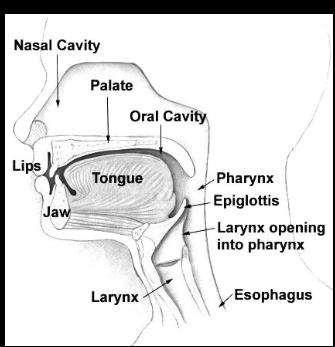
Voiced vs. unvoiced: Voiced sounds involve vibration of the vocal cords (e.g., "z"), while unvoiced sounds do not (e.g., "s").
Fricatives: Sounds produced by forcing air through a narrow space (e.g., "f" and "v").
Plosives: Sounds produced by stopping airflow and releasing it suddenly (e.g., "p" and "t").
What are sound combinations in language, and how do they contribute to words and syllables? (2)
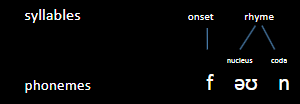
Sound combinations form the syllables and words of a language.
These combinations follow 'legal' phonological structures, which vary across different languages.
What are the components of syllables in phonological structure? (3)
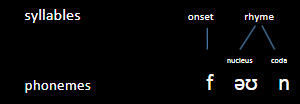
Onset: The initial consonant(s) of a syllable (e.g., "f" in "fun").
Nucleus: The core vowel sound of a syllable (e.g., "ʌ" in "fun").
Coda: The consonant(s) that follow the nucleus (e.g., "n" in "fun").
What are phonemes, and how are they represented? (2)
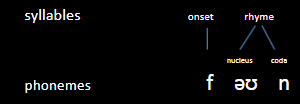
Phonemes are the smallest units of sound in a language that distinguish meaning (e.g., "f," "əʊ," and "n" in "phone").
They are commonly represented using the International Phonetic Alphabet (IPA) for standardized notation.
What is semantics in language? (4)
Semantics refers to the representation of meaning in long-term memory, focusing on concepts and the relations between them.
It involves actions, objects, and properties expressed through verbs, nouns, and adjectives.
Semantics is largely independent of grammar.
The mapping between concepts and symbols is generally arbitrary, except in cases like onomatopoeia.
What is the role of onomatopoeia in semantics? (1)
Onomatopoeia involves words whose meaning is closely related to their sound, such as 'hiss' for the sound of a snake.
What is syntax in language? (2)
Syntax refers to the arrangement of words and phrases to form well-structured sentences.
It relies on grammatical markers and word order to convey meaning.
How does syntax work in English? (2)
In English, word order (Subject-Verb-Object, or SVO) plays a crucial role in determining the meaning of a sentence.
Example: "The dog bit the man" (SVO) vs. "The man bit the dog" (SVO) – word order changes the roles.
How do other languages handle syntax? (2)
Other languages may rely on markers (like case endings or inflections) to indicate word roles, rather than strict word order.
Example in Latin:
"Canis morduit hominem" (SVO) = "The dog bit the man."
"Hominem morduit canis" (OSV) = "The man bit the dog."
What is comprehension in language? (2)
Comprehension is the ability to represent the meaning of words or sentences spoken or written by another person.
It requires knowledge of the components of language (e.g., syntax, semantics) but also involves understanding context, pitch, stress, and prosody.
How does context influence comprehension? (1)
Context helps clarify meaning, as in:
"I reached the bank": This could mean a financial institution or the side of a river, depending on the context.
How does pitch affect comprehension? (1)
In some languages, pitch can alter meaning.
Example: In Mandarin Chinese, words like shī, shì, shí, and shî (differing in tone) have different meanings despite being spelled the same in pinyin.
How does stress affect comprehension? (3)
Stress on different words in a sentence can change its meaning:
"Do YOU live here?" emphasizes the person being questioned.
"Do you LIVE here?" emphasizes the action of living.
"Do you live HERE?" emphasizes the location.
Picture demonstrating the Cerebral organisation of language:
‘THE LANGUAGE NETWORK
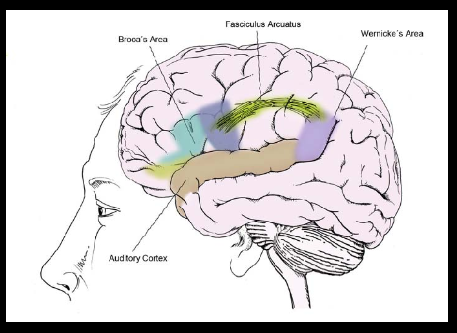
What is the cerebral organisation of articulation and phonology in language? (1)
Articulation and phonology are primarily managed by the motor areas and associated regions of the brain involved in speech production. (Details may depend on areas like the Broca's area.)
What brain regions are involved in meaning and semantic processing? (3)
Temporal poles: These are densely interconnected with various regions of the association cortex, facilitating the representation of meaning.
The representation of meaning is often considered modality-independent, meaning it is not reliant on a specific sensory mode (e.g., visual or auditory).
This network allows the brain to process concepts across different forms of input (e.g., spoken, written).
What regions of the brain are involved in syntax processing? (1)
Syntax processing is primarily associated with the left inferior frontal gyrus, which is critical for organizing and structuring sentence elements.
What areas of the brain are involved in comprehension of language? (5)
Primary auditory cortex: Involved in processing sound, including spoken language.
Temporal poles: Involved in the representation of meaning and associated with higher-level comprehension.
Left inferior frontal gyrus: Plays a key role in processing syntactic structure and comprehension.
Arcuate fasciculus: A bundle of fibers that connects language comprehension areas to language production areas.
Left posterior superior temporal gyrus: Key in processing and understanding spoken language.
What are the types of aphasia that can result from a stroke? (4)
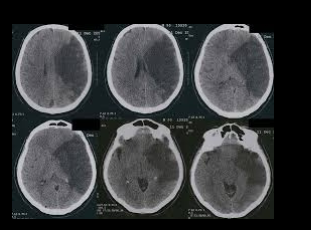
Broca’s aphasia
Wernicke’s aphasia
Conduction aphasia
Adynamic aphasia
What are the characteristics of Broca’s aphasia? (4)

Articulation and phonology: Difficulty with speech production, resulting in halting, fragmented, and distorted speech.
Speech: The speech is often agrammatic (lacking grammatical structure).
Comprehension: Comprehension of words is generally preserved, but there is reduced comprehension for complex sentences.
Brain area affected: Damage to Broca’s area, located in the left inferior frontal gyrus.
What are the typical pathologies associated with Broca’s aphasia? (2)
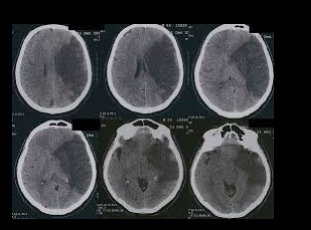
Middle cerebral artery infarction: A blockage in the middle cerebral artery can lead to Broca's aphasia.
Haemorrhagic stroke: Bleeding in the brain, which can affect the same areas involved in speech production.
What is Wernicke’s aphasia also known as? (2)
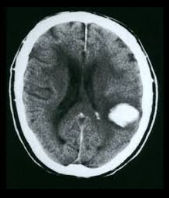
Receptive aphasia
Sensory aphasia
What are the characteristics of Wernicke’s aphasia? (3)
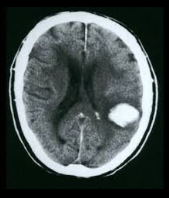
Speech: Fluent speech that often contains meaningless phonological strings (nonsensical or jumbled words).
Comprehension: Severely impaired, making it difficult to understand spoken or written language.
Brain area affected: Damage occurs to posterior regions of the language network, including Wernicke’s area in the left posterior temporal lobe.
What are the typical pathologies associated with Wernicke’s aphasia? (2)
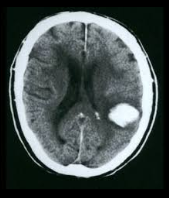
Penetrating brain injury: Trauma that directly affects the language-related regions of the brain.
Cerebral haemorrhage: Bleeding in the brain, affecting language comprehension and production areas.
What are the main characteristics of Conduction aphasia? (2)
Difficulty with repetition: Individuals with conduction aphasia struggle to repeat words or sentences accurately.
Speech characteristics: Mild fluency and comprehension difficulties, but speech is relatively fluent.
What test is used to assess Conduction aphasia? (1)
Single word and sentence repetition: This is typically tested to identify difficulties in repeating speech accurately.
What areas of the brain are affected in Conduction aphasia? (2)
Damage occurs in the posterior perisylvian regions (areas around the Sylvian fissure).
Damage also affects the underlying white matter, particularly the arcuate fasciculus, which connects language comprehension and production areas.
What is the typical pathology associated with Conduction aphasia? (1)
Lacunar stroke: A small, deep stroke that affects specific areas of the brain, often resulting in conduction aphasia.
What are the main characteristics of Dynamic aphasia? (2)
Difficulty with planning, initiating, or maintaining speech: Individuals struggle with organizing and producing speech.
Speech characteristics: Speech tends to be reduced, fragmentary, echoic (repeating words), and perseverative (repeating phrases or ideas).
What test is used to assess Dynamic aphasia? (1)
High vs. low constraint sentence completion: This test helps assess the person's ability to generate speech based on different levels of constraints.
What areas of the brain are affected in Dynamic aphasia? (2)
Damage occurs in the anterior left inferior frontal gyrus (specifically BA 45, part of Broca’s area).
This area is involved in speech planning and initiation.
What is the typical pathology associated with Dynamic aphasia? (1)
Left anterior cerebral artery infarction: A stroke in the anterior cerebral artery affecting areas of speech production in the frontal lobe.
What are the types of aphasia associated with neurodegeneration? (3)
Nonfluent progressive aphasia
Fluent progressive aphasia
Logopenic progressive aphasia
What are the characteristics of Non-fluent progressive aphasia? (4)
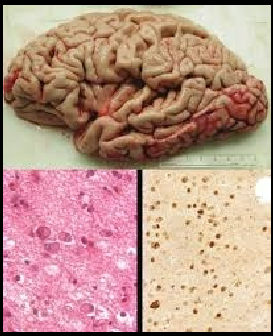
Slow, distorted, agrammatic speech: Speech becomes progressively slower, distorted, and lacks grammatical structure.
Progressive course: Symptoms begin subtly and worsen over time.
Phonological and grammatical errors: Individuals make errors in pronunciation and grammar in spontaneous speech.
Single word comprehension: This is generally well-preserved, but there is difficulty understanding sentences.
What is the typical pathology associated with Non-fluent progressive aphasia? (1)
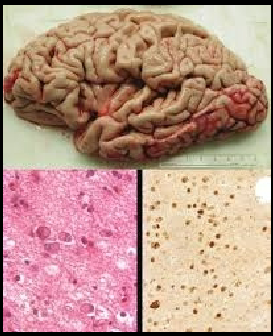
Primary tauopathy (FTD-Tau): A neurodegenerative condition, particularly frontotemporal dementia (FTD) associated with tau protein abnormalities.
What are the characteristics of Fluent progressive aphasia? (4)
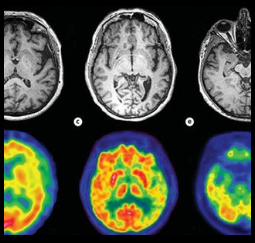
Normal sounding speech rate and production: Speech flows at a normal pace but lacks meaningful content.
Subtle word-finding changes: Begins with difficulties in finding the right words.
Generic word and pronoun use: In spontaneous speech, generic terms and pronouns are often used instead of specific words.
Profound single word comprehension difficulties: Understanding individual words becomes severely impaired.
What is the location of the pathology in Fluent progressive aphasia? (1)
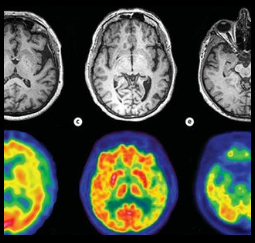
Anterior temporal regions: Damage occurs in the anterior regions of the temporal lobes, important for word meaning.
What is the typical pathology associated with Fluent progressive aphasia? (1)
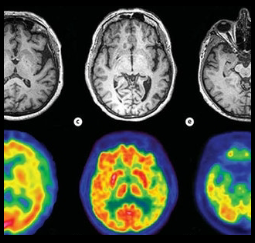
TDP-43 proteinopathy (FTD-TDP): A neurodegenerative condition related to the abnormal accumulation of TDP-43 protein in the brain, often seen in frontotemporal dementia.
What are the characteristics of Logopenic progressive aphasia? (4)
Subtle word-finding changes: Initial difficulties in retrieving words during speech.
Poverty of speech output: Reduced speech output, with difficulty producing fluent speech.
Occasional errors in syntax and phonology: Occasional grammatical and phonological mistakes in speech.
Poor sentence repetition: Difficulty repeating sentences accurately.
What is the location of the pathology in Logopenic progressive aphasia? (1)
Posterior perisylvian pathology: Damage occurs in the posterior regions around the Sylvian fissure, which are crucial for speech and language processing.
What is the typical pathology associated with Logopenic progressive aphasia? (1)
Alzheimer’s disease: Logopenic progressive aphasia is often associated with Alzheimer's disease, which leads to neurodegeneration in language-related brain regions.
What is Alveolar in phonetics? (1)
Alveolar: A phonetic description of sounds produced with the tongue close to or touching the ridge behind the teeth on the roof of the mouth.
What is the role of the Auditory cortex in the brain? (2)
Auditory cortex: Located in the superior temporal gyri of each hemisphere, it plays a critical role in the perception and localisation of sounds.
It processes auditory information received from the ears.
What is Broca's area and its function? (2)
Broca's area: A region in the posterior section of the left frontal lobe involved in the expressive aspects of spoken and written language.
It is critical for language production, including speech formation and grammar.
What is the Fasciculus arcuatus? (1)
Fasciculus arcuatus: A collection of myelinated axons that connects Broca's area and Wernicke's area in the brain, facilitating communication between language-related regions.
What is a Fricative sound in phonetics? (1)
Fricative: A phonetic description of sounds produced by bringing the mouth into position to block the passage of the airstream, but not making a complete closure, causing audible friction (e.g., English letters f or v).
What is Labial in phonetics? (1)
Labial: A phonetic description of sounds that require the participation of one or both lips.
What is Onomatopoeia? (1)
Onomatopoeia: Words that describe a sound and mimic the sound of the object or action they refer to when spoken (e.g., hiss, splash, slam).
What is Palatal in phonetics? (1)
Palatal: A phonetic description of sounds produced with the middle of the tongue against the hard palate.
What is a Plosive sound in phonetics? (1)
Plosive: A phonetic description of sounds made by blocking a part of the mouth so that no air can pass through. Pressure builds up behind the block, and when the air is released, a sound is created (e.g., English letters p, b).
What is Semantics in language? (1)
Semantics: The brain's system for representing conceptual (shared) knowledge in long-term memory, which relates to the meaning of words and sentences.
What is Wernicke's area and its function? (2)
Wernicke's area: A region in the parieto-temporal region on the left side of the brain.
It is important for language production and comprehension, particularly for understanding spoken and written language.